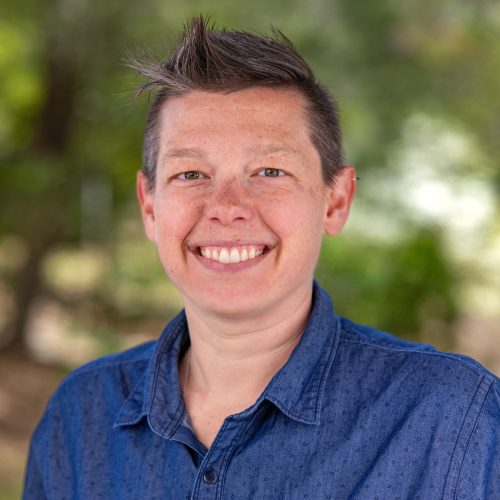
Amanda Wolfe, Ph.D.
Associate Professor; Medicinal Chemistry, GlaxoSmithKline Distinguished Professor in Molecular and Chemical BiologyContact Information
- awolfe@unca.edu
- 251-6957
- 111 Zeis Hall
Office Hours
- Monday 10:30 am - 12:30 pm
- Thursday 10:30 am - 12:30 pm
- Note: And by appointment. Online (see Moodle for link).
Courses Taught
- CHEM 222 Organic Chemistry Laboratory
- CHEM 231 Organic Chemistry I
- CHEM 232 Organic Chemistry II
- CHEM 312 Interdisciplinary Project Laboratory
- CHEM 323 Foundations of Biochemistry
- CHEM 336 Bioorganic Chemistry
- CHEM 436 Biochemistry
- CHEM 446 Medicinal Chemistry
Education
- Ph.D. The Scripps Research Institute, Organic Chemistry
- B.S. North Carolina State University
- Facebook Research Page
About Me
I am originally from Bridgeport, West Virginia, and I graduated summa cum laude from North Carolina State University with a B.S. in Chemistry in 2008. At NCSU I worked under Professor Christian Melander on the development of 2-aminoimidazole bacteria biofilm inhibitors. I then attended graduate school at the Scripps Research Institute in San Diego, California where I worked in Professor Dale Boger’s lab. My main PhD thesis was on the synthesis and evaluation of prodrugs of the duocarmycin family of natural products, which are naturally occurring anticancer agents. I graduated with my PhD in June 2013 and immediately moved to Asheville to begin my independent career at UNC Asheville.
Teaching Interests
My teaching interests lie in making organic chemistry a vital course in any biologically oriented curriculum. I develop my courses with a focus on application (biological, environmental, material etc.) and technology development. In addition to teaching the fundamentals of organic chemistry and organic lab, I am working on the development of a medicinal chemistry course that will be centered around case studies of current pharmaceuticals on the market.
Research interests
The Wolfe Lab’s research focus is divided into two different fields of organic chemistry: 1) medicinal chemistry and 2) natural product isolation.
Our medicinal chemistry program involves the development, synthesis, and biological evaluation of antibacterial agents derived from naturally occurring molecules. Our target molecules include ficellomycin, pestalone, depsidones, and p-terphenyls, which have all shown promising preliminary activity as antibiotics. In the lab we systematically derivatize each targets core structure to improve both their antibacterial activity and their physical properties in order to make them a viable drug molecule. We will also evaluate our derivatives in house using an antibacterial assay.
Our natural product isolation program explores how bacterial competition between diverse natural bacteria influences expression of secondary metabolite antibiotics compared to standard laboratory conditions. In collaboration with Dr. Sarah Seaton (UNC Asheville Biology Department), we induce antibiotic production in bacteria isolated from water and soil in western North Carolina by co-culturing it with another bacteria in a single solution. We then isolate the small molecule antibiotics produced during co-culture using organic chemistry extraction and purification techniques. Finally, all of the isolated metabolites are characterized using IR, NMR, and mass spectrometry. All novel metabolites that we isolate and characterized will then become new targets for our medicinal chemistry program. You can follow Dr. Wolfe's research on her Facebook page or on the Wolfe Lab Website.
Selected Publications
*indicates UNC Asheville Undergraduate Co-author
- Murphy, K. E.; Sloan, G. F.;* Lawhern, G. V.;* Volk, G. E.;* Shumate, J. T.;* Wolfe, A. L. Advances in antibiotic drug discovery: Reducing the barriers for antibiotic development” Future Medicinal Chemistry 2020, 12(22), 2067-2087. https://www.future-science.com/doi/10.4155/fmc-2020-0247. Invited
- Fields, L.;* Craig, W. R.; Huffine, C. A.;* Allen, C. F.;* Bouthillette, L. M.;* Chappell, J. C.;* Shumate, J. T.;* Wolfe, A. L. “Short chain alpha-pyrones capable of potentiating penicillin G against Pseudomonas aeruginosa” Bioorganic and Medicinal Chemistry Letters 2020, 30(16), 127301.
- Fields, L.;* Craig, W. R.; Wasileski, S. A.; Wolfe, A. L. “Effects of Shade on Antibacterial Production in Aloe Vera Plants: A Model Course Based Undergraduate Research Experience for First- and Second-Year Chemistry and Biochemistry Students” World Journal of Chemical Education 2019, 7(4), 248.
- Murray, E. M.;* Allen, C. F.;* Handy, T. E.;* Huffine, C. A.;* Craig, W. R.; Seaton, S. C.; Amanda L. Wolfe. Development of a Robust and Quantitative High Throughput Screening Method for Antibiotic Production in Bacterial Libraries. ACS Omega 2019, 4, 15414.
- Bouthillette, L. M.;* Darcey, C. A.;* Handy, T. E.;* Seaton, S. C.; Wolfe, A. L. Isolation of the Antibiotic Pseudopyronine B and SAR Evaluation of C3/C6 Alkyl Analogs. Bioorg. Med. Chem. Lett. 2017, DOI: 10.1016/j.bmcl.2017.04.067.
- Wolfe, A. L.; Duncan, K. K.; Lajiness, J. P.; Zhu, K.; Boger, D. L.A fundamental relationship between hydrophobic properties and biological activity for the duocarmycin SA class of antitumor drugs: hydrophobic binding-driven-bonding. J. Med. Chem. 2013, 56, 6845.
- Wolfe, A. L.; Duncan, K. K.; Parelkar, N. K.; Weir, S. J.; Vielhauer, G. A.; Boger, D. L. Efficacious cyclic N-acyl O-amino phenol duocarmycin prodrugs. J. Med. Chem. 2013, 56, 4104.
- Vielhauer, G. A.; Swink, M.; Parelkar, N. K.; Lajiness, J. P.; Wolfe, A. L.; Boger, D. L. Characterization of a duocarmycin prodrug against solid cancers. Cancer Biology and Therapy 2013, 14, 527.
- Xie, J.; Wolfe, A. L.; Boger, D. L. Total synthesis of kopsinine. Org. Let., 2013, 15, 868.
- Wolfe, A. L.; Duncan, K. K.; Parelkar, N. K.; Weir, S. J.; Vielhauer, G. A.; Boger, D. L. A novel, unusually efficacious duocarmycin carbamate prodrug that releases no residual byproduct J. Med. Chem. 2012, 55, 5878.
- Ballard, T. E.; Richards, J. J.; Wolfe, A. L.; Melander, C. Synthesis and anti-biofilm activity of a second generation reverse amide oroidin library: an SAR study.Chem. Eur. J. 2008, 14, 10745.
- Mammana, A.; Asakawa, T.; Bitsch-Jensen, K.; Wolfe, A.; Chaturantabut, S.; Otani, Y.; Li, X.; Li, Z.; Nakanishi, K.; Balaz, M.; Ellestad, G. A.; Berova, N. Synthesis and characterization of watersoluble free-base, zinc and copper porphyrin-oligonucleotide conjugates. Bioorg. Med. Chem. 2008, 16, 6544.